Determination, Mobility and Risk Assessment of Pesticides in Ginseng Wine Using Dispersive Liquid–Liquid Micro Extraction Combined with GC-MS/MS and LC-MS/MS
Abstract
1. Introduction
2. Materials and Methods
2.1. Chemicals, Reagents, and Materials
2.2. Sample Preparation
2.3. LC-MS/MS Analysis
2.4. GC-MS/MS Analysis
2.5. Calibration, Detection, and Quantification
2.6. Recovery Assays
3. Results and Discussion
3.1. Optimization of GC-MS/MS
3.2. Linearity, Limits of Detection (LODs), and Limits of Quantification (LOQ)
3.3. Optimization of Extraction
3.4. Optimization of Water/Salt Solution
3.5. Optimization of Dispersant
3.6. Accuracy and Precision
3.7. Real Samples Analysis
4. Migration Studies
4.1. Test Time, Place and Sample Collection
4.2. Setup of Migration Studies
4.3. Sample Preparation of Migration Studies
4.4. Sample Determination
4.5. Test Results and Analyses
4.5.1. Results of Pesticide Screening of Fresh Ginseng Before Brewing
4.5.2. Pesticide Residues in Ginseng Wine
4.5.3. Discussion
4.6. Dietary Risk of Ginseng Wine
5. Conclusions
Supplementary Materials
Author Contributions
Funding
Data Availability Statement
Conflicts of Interest
References
- Kim, J.H.; Yi, Y.S.; Kim, M.Y.; Cho, J.Y. Role of ginsenosides, the main active components of Panax ginseng, in inflammatory responses and diseases. J. Ginseng Res. 2017, 41, 435–443. [Google Scholar] [CrossRef] [PubMed]
- Gu, L.D.; Lee, J.S.; Kim, K.T.; Kim, H.Y.; Lee, S. Analysis of major ginsenosides in various ginseng samples. J. Biol. Chem. 2019, 62, 87–91. [Google Scholar]
- In, G.; Ahn, N.G.; Bae, B.S.; Lee, M.W.; Park, H.W.; Jang, K.H.; Cho, B.G.; Han, C.K.; Park, C.K.; Kwak, Y.S. In situ analysis of chemical components induced by steaming between fresh ginseng, steamed ginseng, and red ginseng. J. Ginseng Res. 2017, 41, 361–369. [Google Scholar] [CrossRef] [PubMed]
- Colzani, M.; Altomare, A.; Caliendo, M.; Aldini, G.; Righetti, P.G.; Fasoli, E. The secrets of Oriental panacea: Panax ginseng. J. Proteomics. 2016, 130, 150–159. [Google Scholar] [CrossRef]
- Lee, J.I.; Park, K.S.; Cho, I.H. Panax ginseng: A candidate herbal medicine for autoimmune disease. J. Ginseng Res. 2019, 43, 342–348. [Google Scholar] [CrossRef]
- Zhang, X.; Gao, Y.G.; Zang, P.; Zhao, Y.; Zhu, H.Y.; He, Z.M. Effects of four new processing technologies on pesticide residues and saponins content in ginseng. J. Food Process Pres. 2020, 44, 7. [Google Scholar] [CrossRef]
- Ye, J.; Gao, Y.X.; Tian, S.S.; Su, J.; Zhang, W.D. A novel and effective mode-switching triple quadrupole mass spectrometric approach for simultaneous quantification of fifteen ginsenosides in Panax ginseng. Phytomedicine 2018, 44, 164–172. [Google Scholar] [CrossRef]
- Wu, P.L.; Gu, M.Y.; Wang, Y.J.; Xue, J.; Wu, X.L. Transfer of Organochlorine Pesticide Residues during Household and Industrial Processing of Ginseng. J. Food Qual. 2020, 2020, 1–9. [Google Scholar] [CrossRef]
- Yao, C.L.; Wang, J.; Li, Z.W.; Qu, H.; Pan, H.Q.; Li, J.Y.; Wei, W.L.; Zhang, J.Q.; Bi, Q.R.; Guo, D.A. Characteristic malonyl ginsenosides from the leaves of Panax notoginseng as potential quality markers for adulteration detection. J. Agric. Food Chem. 2021, 69, 4849–4857. [Google Scholar] [CrossRef]
- Fan, S.S.; Zhang, Z.P.; Su, H.; Xu, P.; Qi, H.Y.; Zhao, D.Q.; Li, X.Y. Panax ginseng clinical trials: Current status and future perspectives. Biomed. Pharmacother. 2020, 132, 110932. [Google Scholar] [CrossRef]
- Stachniuk, A.; Fornal, E. Liquid Chromatography-Mass Spectrometry in the Analysis of Pesticide Residues in Food. Food Anal. Methods 2016, 9, 1654–1665. [Google Scholar]
- Anagnostopoulos, C.J.; Sarli, P.A.; Liapis, K.; Haroutounian, S.A.; Miliadis, G.E. Validation of Two Variations of the QuEChERS Method for the Determination of Multiclass Pesticide Residues in Cereal-Based Infant Foods by LC-MS/MS. Food Anal. Methods 2012, 5, 664–683. [Google Scholar] [CrossRef]
- Cherta, L.; Beltran, J.; Pitarch, E.; Hernandez, F. Comparison of Simple and Rapid Extraction Procedures for the Determination of Pesticide Residues in Fruit Juices by Fast Gas Chromatography-Mass Spectrometry. Food Anal. Methods 2013, 6, 1671–1684. [Google Scholar]
- Tong, H.F.; Tong, Y.L.; Xue, J.; Liu, D.J.; Wu, X.B. Multi-residual Pesticide Monitoring in Commercial Chinese Herbal Medicines by Gas Chromatography-Triple Quadrupole Tandem Mass Spectrometry. Food Anal. Methods 2014, 7, 135–145. [Google Scholar] [CrossRef]
- Chen, L.N.; Yin, L.H.; Song, F.R.; Liu, Z.Q.; Zheng, Z.; Xing, J.P.; Liu, S.Y. Determination of pesticide residues in ginseng by dispersive liquid-liquid microextraction and ultra high performance liquid chromatography-tandem mass spectrometry. J. Chromatogr. B 2013, 917, 71–77. [Google Scholar]
- Wu, R.X.; Chen, Q.Y.; Li, S.J.; Fan, G.L. Simultaneous Determination of 27 Pesticides in Ginseng by UPLC/MS/MS and Modified QuEChERS Procedure. J. AOAC Int. 2015, 98, 839–846. [Google Scholar] [CrossRef]
- Chen, Y.; Lopez, S.; Hayward, D.G.; Park, H.Y.; Wong, J.W.; Kim, S.S.; Wan, J.; Reddy, R.M.; Quinn, D.J.; Steiniger, D. Determination of Multiresidue Pesticides in Botanical Dietary Supplements Using Gas Chromatography-Triple-Quadrupole Mass Spectrometry (GC-MS/MS). J. Agric. Food Chem. 2016, 64, 6125–6132. [Google Scholar]
- Chowdhury, M.E.K.; Bae, H. Bacterial endophytes isolated from mountain-cultivated ginseng (Panax ginseng Mayer) have biocontrol potential against ginseng pathogens. Biol. Control 2018, 126, 97–108. [Google Scholar]
- Lu, Z.; Fang, N.; Liu, Y.J.; Zhang, Z.B.; Pan, H.Y.; Hou, Z.G.; Li, Y.R.; Lu, Z.B. Dissipation and residues of the diamide insecticide chlorantraniliprole in ginseng ecosystems under different cultivation environments. Environ. Monit. Assess. 2017, 189, 534. [Google Scholar]
- Narenderan, S.T.; Meyyanathan, S.N.; Babu, B. Review of Pesticide Residue Analysis in Fruits and Vegetables. Pre-Treatment, Extraction and Detection Techniques. Food Res. Int. 2020, 133, 109141. [Google Scholar]
- Makni, Y.; Diallo, T.; Guérin, T.; Parinet, J. Improving the Monitoring of Multi-Class Pesticides in Baby Foods Using QuEChERS-UHPLC-Q-TOF with Automated Identification Based on MS/MS Similarity Algorithms. Food Chem. 2022, 395, 133573. [Google Scholar] [CrossRef] [PubMed]
- Moinfar, S.; Khodayari, A.; Abdulrahman, S.S.; Aghaei, A.; Sohrabnezhad, S.; Jamil, L.A. Development of a SPE/GC–MS Method for the Determination of Organophosphorus Pesticides in Food Samples Using Syringe Filters Packed by GNP/MIL-101(Cr) Nanocomposite. Food Chem. 2022, 371, 130997. [Google Scholar] [CrossRef]
- Cunha, S.C.; Fernandes, J.O.; Oliveira, M.B.P.P. Fast Analysis of Multiple Pesticide Residues in Apple Juice Using Dispersive Liquid-Liquid Microextraction and Multidimensional Gas Chromatography-Mass Spectrometry. J. Chromatogr. A 2009, 1216, 8835–8844. [Google Scholar] [CrossRef] [PubMed]
- Farajzadeh, M.A.; Kiavar, L.; Pezhhanfar, S. Development of a Method Based on Dispersive Liquid–Liquid Microextraction Followed by Partial Vaporization of the Extract for Ultra–Preconcentration of Some Pesticide Residues in Fruit Juices. J. Chromatogr. A 2021, 1653, 462427. [Google Scholar] [CrossRef] [PubMed]
- Deng, K.J.; Lan, X.H.; Sun, G.; Ji, L.Y.; Zheng, X.L. Determination of Sulfonamide Residues in Chicken Liver Using High-Performance Liquid Chromatography. Food Anal. Methods 2016, 9, 3337–3344. [Google Scholar] [CrossRef]
- Moema, D.; Nindi, M.M.; Dube, S. Development of a dispersive liquid–liquid microextraction method for the determination of fluoroquinolones in chicken liver by high performance liquid chromatography. Anal. Chim. Acta 2012, 730, 80–86. [Google Scholar] [CrossRef]
- Han, D.D.; Tang, B.K.; Lee, Y.R.; Row, K.H. Application of ionic liquid in liquid phase microextraction technology. J. Sep. Sci. 2015, 35, 2949. [Google Scholar] [CrossRef]
- Liu, B.; Yan, H.; Qiao, F.; Geng, Y. Determination of clenbuterol in porcine tissues using solid-phase extraction combined with ultrasound-assisted dispersive liquid-liquid microextraction and HPLC-UV detection. J. Chromatogr. B Anal. Technol. Biomed. Life Sci. 2011, 879, 90–94. [Google Scholar] [CrossRef]
- Viñas, P.; López-García, I.; Bravo-Bravo, M.; Briceño, M.; Hernández-Córdoba, M. Dispersive liquid-liquid microextraction coupled to liquid chromatography for thiamine determination in foods. Anal. Bioanal. Chem. 2012, 403, 1059–1066. [Google Scholar] [CrossRef]
- Cha, K.M.; Lee, E.S.; Kim, I.W.; Cho, H.K.; Ryu, J.H.; Kim, S.K. Canola oil is an excellent vehicle for eliminating pesticide residues in aqueous ginseng extract. J. Ginseng Res. 2016, 40, 292–299. [Google Scholar] [CrossRef]
- Zhang, X.; Gao, Y.G.; Zang, P.; Zhao, Y.; He, Z.M.; Zhu, H.Y.; Song, S.N.; Zhang, L.X. Study on the simultaneous degradation of five pesticides by Paenibacillus polymyxa from Panax ginseng and the characteristics of their products. Ecotoxicol. Environ. Saf. 2019, 168, 415–422. [Google Scholar] [CrossRef] [PubMed]
- Kocúrová, L.; Balogh, I.S.; Šandrejová, J.; Andruch, V. Recent advances in dispersive liquid–liquid microextraction using organic solvents lighter than water. A Review. Microchem. J. 2012, 102, 11–17. [Google Scholar] [CrossRef]
- Ma, J.; Lu, W.; Chen, L. Recent Advances in Dispersive Liquid–Liquid Microextraction for Organic Compounds Analysis in Environmental Water: A Review. Curr. Anal. Chem. 2012, 8, 78–90. [Google Scholar] [CrossRef]
- Li, S.; Chen, Y.H.; Li, S.K.; Xu, D.P.; Zou, Z.F.; Li, H.B. Recent Development and Application of Dispersive Liquid-Liquid Microextraction. Int J. Food Sci. Nutr. 2013, 3, 171–204. [Google Scholar]
- Padilla-Alonso, D.J.; Garza-Tapia, M.; Chávez-Montes, A.; González-Horta, A.; Waksmande Torresa, N.H.; Castro-Ríos, R. New temperature-assisted ionic liquid-based dispersive liquid–liquid microextraction method for the determination of glyphosate and aminomethylphosphonic acid in water samples. J. Liq. Chromatogr. Relat. Technol. 2017, 40, 147–155. [Google Scholar]
- Ballesteros-Gómez, A.; Rubio, S.; Pérez-Bendito, D. Potential of supramolecular solvents for the extraction of contaminants in liquid foods. J. Chromatogr. A 2009, 121, 530–539. [Google Scholar] [CrossRef]
- Vázquez, M.P.; Vázquez, P.P.; Galera, M.M.; García, M.G.; Uclés, A. Ultrasound-assisted ionic liquid dispersive liquid–liquid microextraction coupled with liquid chromatography-quadrupole-linear ion trap-mass spectrometry for simultaneous analysis of pharmaceuticals in wastewaters. J. Chromatogr. A 2013, 1291, 19–26. [Google Scholar] [CrossRef]
- Yan, H.; Wang, H. Recent development and applications of dispersive liquid–liquid microextraction. J. Chromatogr. A 2013, 1295, 1–15. [Google Scholar] [CrossRef]
- Hassan, S.; Parisa, K.; Nina, N. Recent trends in replacement of disperser solvent in dispersive liquid-liquid microextraction methods. Sep. Purif. Rev. 2018, 48, 159–178. [Google Scholar]
- Mingtao, H.; Xiaoran, L.; Rui, C.; Naichao, C. Ginsenosides’ Dissolution Performance and Distribution Characteristics in Alcohol. J. Ginseng Res. 2020, 32, 2–8. [Google Scholar]
- GB/T 27404-2008; Laboratory Quality Control Practices, Physical and Chemical Testing of Food. China National Standardization Administration: Beijing, China, 2008.
- GB 2763-2021; Maximum Residue Limits for Pesticides in Food. National Health Commission of the People’s Republic of China, Ministry of Agriculture and Rural Affairs of the People’s Republic of China, State Administration for Market Regulation: Beijing, China, 2021.
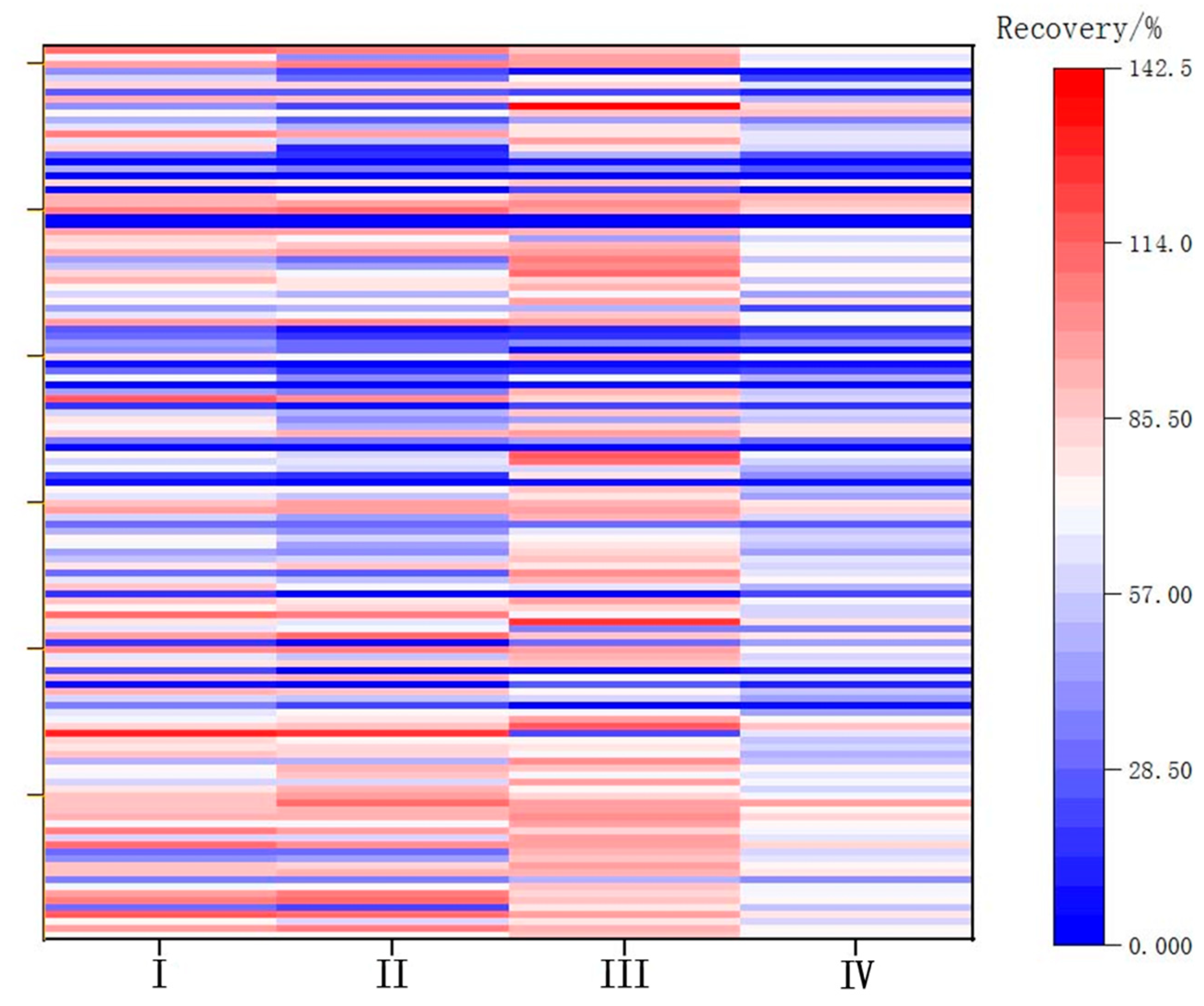
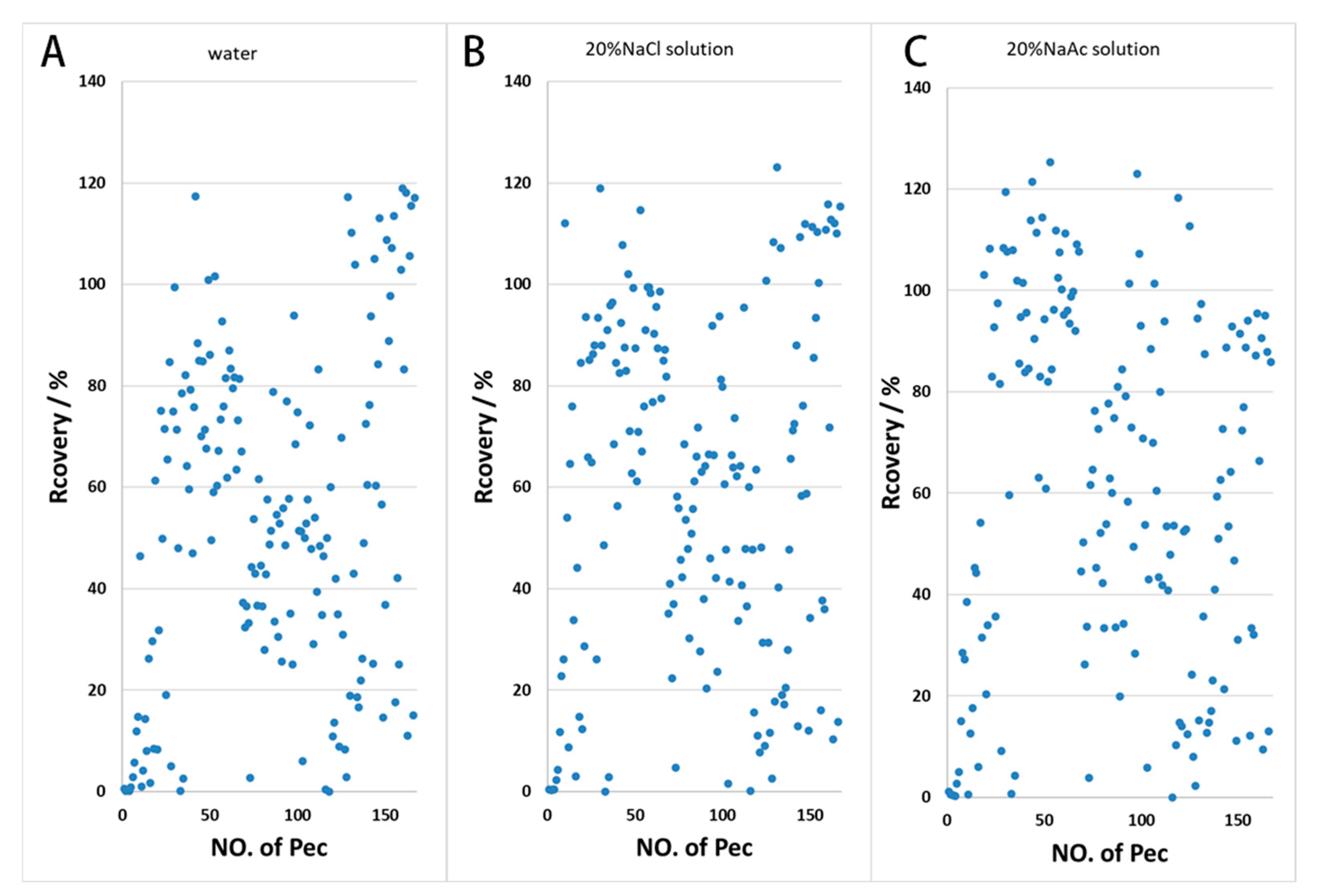
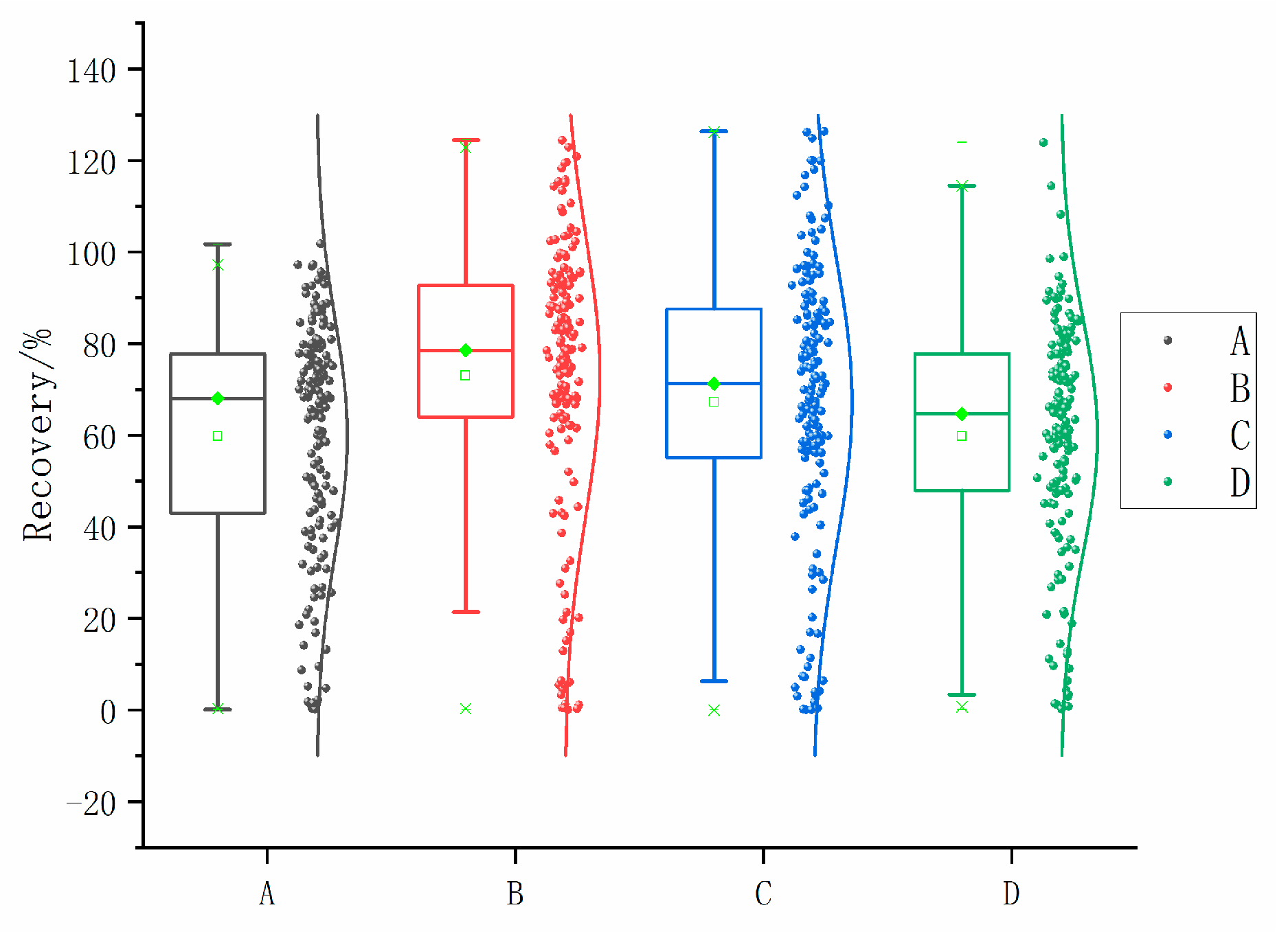

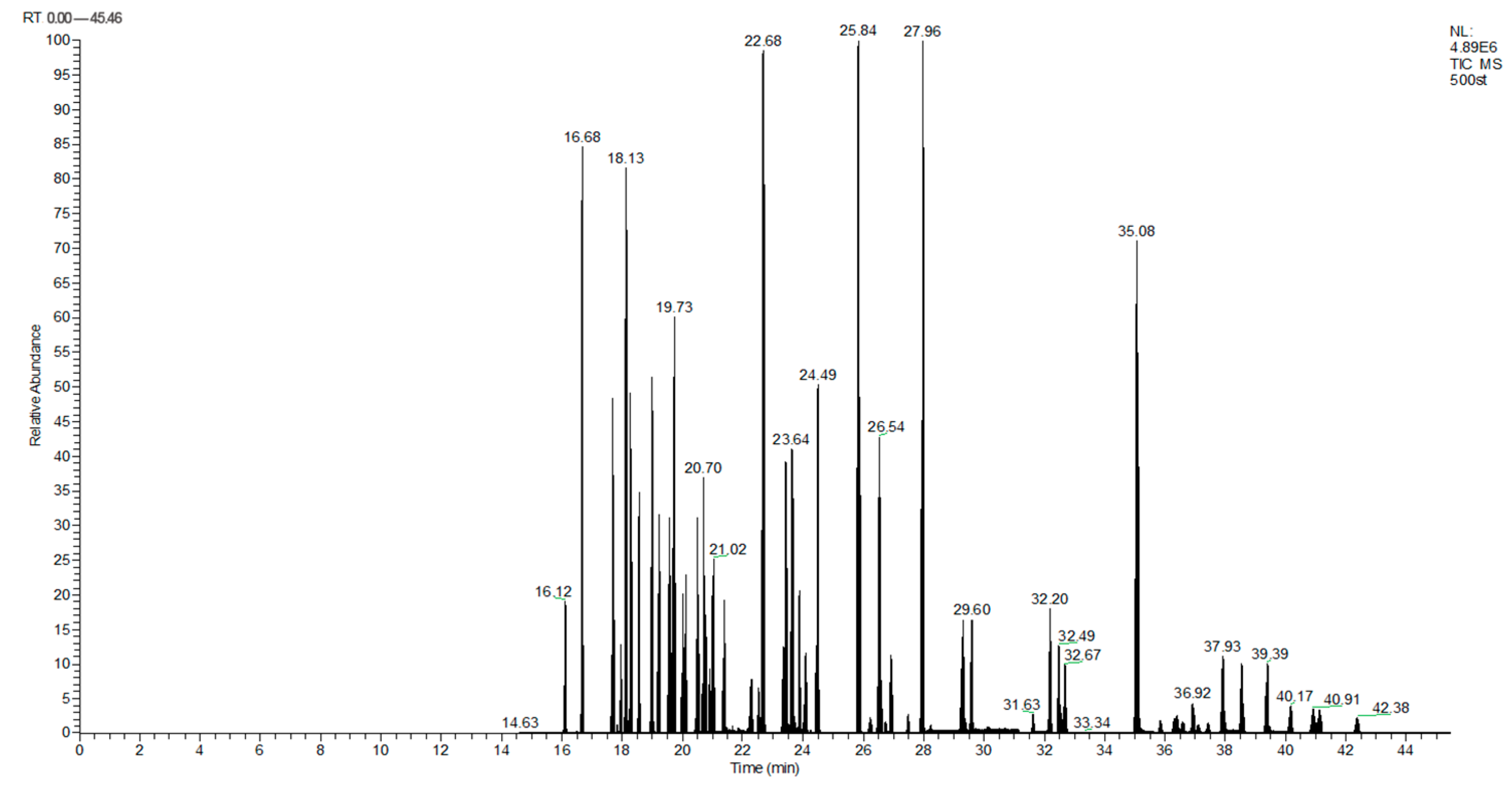

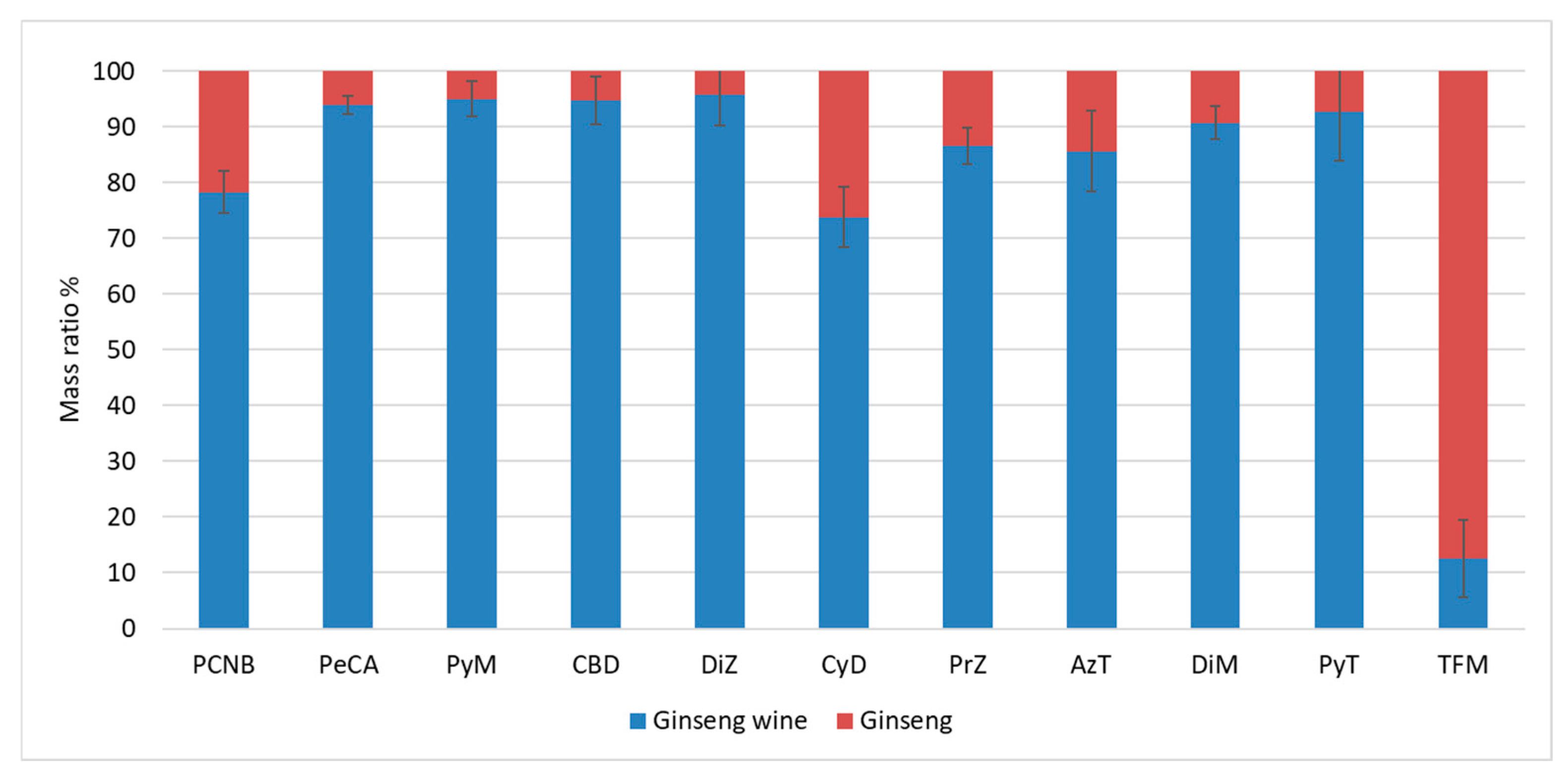
| No. | Alcohol Content/% | Pesticide Content/μg L−1 |
|---|---|---|
| 1 | 42 | Dimethomorph, 0.17; Carbendazim, 0.031 |
| 2 | 42 | <LOD |
| 3 | 38 | <LOD |
| 4 | 52 | Difenoconazole, 0.053 |
| 5 | 52 | <LOD |
| 6 | 38 | <LOD |
| 7 | 40 | Azoxystrobin, 0.14; Pyrimethanil, 0.057 |
| 8 | 40 | <LOD |
| 9 | 38 | Dimethomorph, 0.050; Pyraclostrobin, 0.23 |
| 10 | 38 | <LOD |
| No. | Pesticide | Abbreviation | Sample pcs | Means mg·kg−1 | MRL [42] mg·kg−1 |
|---|---|---|---|---|---|
| 1 | azoxystrobin | AzT | 3 | 0.029~0.087 | 1 |
| 2 | pyrimethanil | PyM | 8 | 0.032~0.14 | 1.5 |
| 3 | carbendazim | CBD | 2 | 0.0043~0.032 | - |
| 4 | dimethomorph | DiM | 7 | 0.0044~0.020 | 0.1 |
| 5 | difenoconazole | DiZ | 2 | 0.012~0.11 | 0.5 |
| 6 | pyraclostrobin | PyT | 3 | 0.0065~0.035 | 0.2 |
| 7 | cyprodinil | CyD | 4 | 0.012~0017 | 0.2 |
| 8 | tebuconazole | TeZ | 1 | 0.0067 | 0.15 |
| 9 | phoxim | PhX | 2 | 0.0042~0.021 | - |
| 10 | chlorpyrifos | CPF | 2 | 0.0033~0.013 | 0.5 |
| 11 | propiconazole | PrZ | 4 | 0.032~0.13 | 0.1 |
| 12 | thifluzamide | TFM | 4 | 0.0056~0.074 | 1 |
| 13 | Quintozene | PCNB | 10 | 0.073~57.2 | 0.1 |
| 14 | pentachloroaniline | PeCA | 10 | 0.032~21.7 | - |
| Pesticide | Abbreviation | Ginseng Wine | Fresh Ginseng | ||||
|---|---|---|---|---|---|---|---|
| Residues | Recovery | RSD% | Residues | Recovery | RSD% | ||
| μg/L | % | μg/kg | % | ||||
| azoxystrobin | AzT | 0.054~0.16 | 72.3 | 9.3 | 1.12~4.7 | 113.2 | 5.3 |
| pyrimethanil | PyM | 0.043~0.77 | 103.2 | 11.2 | 0.21~0.53 | 98.5 | 4.3 |
| carbendazim | CBD | 0.17~1.4 | 30.2 | 13.4 | 0.18~2.4 | 94.3 | 2.9 |
| dimethomorph | DiM | 0.085~1.4 | 79.4 | 12.3 | 0.1~0.23 | 113.2 | 11.2 |
| difenoconazole | DiZ | 0.032~0.42 | 73.4 | 7.5 | 0.022~0.25 | 114.5 | 8.4 |
| cyprodinil | CyD | 0.094 | 75.5 | 4.5 | 0.44 | 78.5 | 12.3 |
| pyraclostrobin | PyT | 0.076~0.14 | 92.3 | 3.2 | 0.053~0.12 | 109.4 | 6.6 |
| propiconazole | PrZ | 0.0112~1.7 | 85.3 | 7 | 2.47 | 86.5 | 4 |
| thifluzamide | TFM | 0.0023 | 50.4 | 5.6 | 0.12~0.17 | 88.9 | 8.2 |
| Quintozene | PCNB | 42.2~1234.2 | 45.5 | 11.2 | 189~5200 | 84.3 | 1.9 |
| pentachloroaniline | PeCA | 37~1120.2 | 70.3 | 10.7 | 27.4~889 | 92.3 | 3.1 |
| tebuconazole | TeZ | / | 82.3 | 8.2 | / | 92.6 | 5.4 |
| phoxim | PhX | / | 72.3 | 9.2 | / | 89.5 | 7.2 |
| chlorpyrifos | CPF | / | 67.4 | 3.7 | / | 78.5 | 9.2 |
Disclaimer/Publisher’s Note: The statements, opinions and data contained in all publications are solely those of the individual author(s) and contributor(s) and not of MDPI and/or the editor(s). MDPI and/or the editor(s) disclaim responsibility for any injury to people or property resulting from any ideas, methods, instructions or products referred to in the content. |
© 2025 by the authors. Licensee MDPI, Basel, Switzerland. This article is an open access article distributed under the terms and conditions of the Creative Commons Attribution (CC BY) license (https://creativecommons.org/licenses/by/4.0/).
Share and Cite
Xu, X.; Zhao, D.; Zhang, M.; Meng, X.; Chen, Y.; Leng, X.; Liang, S.; Li, Y. Determination, Mobility and Risk Assessment of Pesticides in Ginseng Wine Using Dispersive Liquid–Liquid Micro Extraction Combined with GC-MS/MS and LC-MS/MS. Separations 2025, 12, 85. https://doi.org/10.3390/separations12040085
Xu X, Zhao D, Zhang M, Meng X, Chen Y, Leng X, Liang S, Li Y. Determination, Mobility and Risk Assessment of Pesticides in Ginseng Wine Using Dispersive Liquid–Liquid Micro Extraction Combined with GC-MS/MS and LC-MS/MS. Separations. 2025; 12(4):85. https://doi.org/10.3390/separations12040085
Chicago/Turabian StyleXu, Xuanwei, Dan Zhao, Min Zhang, Xinxin Meng, Ying Chen, Xu Leng, Shuang Liang, and Yueru Li. 2025. "Determination, Mobility and Risk Assessment of Pesticides in Ginseng Wine Using Dispersive Liquid–Liquid Micro Extraction Combined with GC-MS/MS and LC-MS/MS" Separations 12, no. 4: 85. https://doi.org/10.3390/separations12040085
APA StyleXu, X., Zhao, D., Zhang, M., Meng, X., Chen, Y., Leng, X., Liang, S., & Li, Y. (2025). Determination, Mobility and Risk Assessment of Pesticides in Ginseng Wine Using Dispersive Liquid–Liquid Micro Extraction Combined with GC-MS/MS and LC-MS/MS. Separations, 12(4), 85. https://doi.org/10.3390/separations12040085





